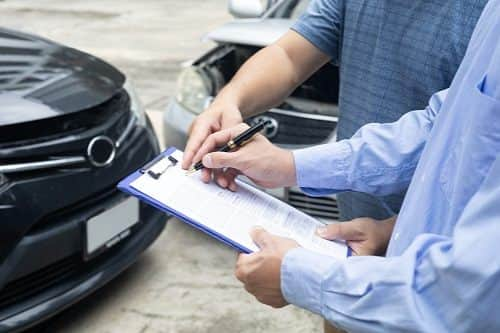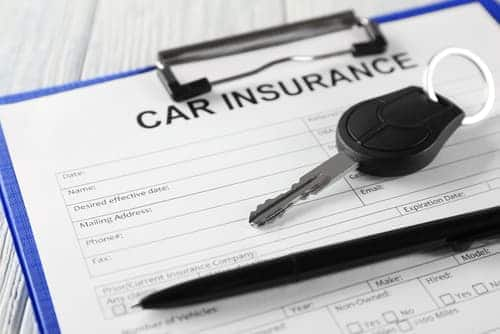- Do motorcycles need insurance?
- What types of vehicles are covered by motorcycle insurance?
- What is the recommended motorcycle insurance coverage?
- How much is a motorcycle insurance policy?
- Is motorcycle insurance expensive?
- How do motorcycle insurance rates change with age?
- Sport vs. touring vs. cruiser: How your motorcycle choice affects your insurance rates
- Are there motorcycle insurance discounts?
- Can I bundle home and motorcycle or get a multi-policy discount?
- The most frequent causes of motorcycle insurance claims
- Frequently asked questions: Motorcycle insurance
Do motorcycles need insurance?
Motorcycles need to be insured because, in most states, motorcycle insurance is required by law. The amount of coverage you need varies from state to state. Even if you live in a state where insurance isn't required, getting insurance for your motorcycle is more than just a good idea. It protects your investment in your motorcycle and protects you from financial fallout if you injure someone else or cause property damage.
If you have a loan on your motorcycle, you will be required to carry full coverage insurance.
What types of vehicles are covered by motorcycle insurance?
Many types of vehicles fall under the motorcycle classification for insurance purposes. You can use motorcycle insurance to cover the following:
- ATVs
- Cruisers
- Dirt bikes
- Racing bikes
- Scooters
- Sport bikes
- Touring bikes
- Trikes
The exact list of vehicles and coverage requirements may depend on the insurer you use. So be sure to ask if your vehicle qualifies for motorcycle insurance when shopping around.
What is the recommended motorcycle insurance coverage?
Motorcycle insurance coverage will vary depending on the individual and their needs. However, some of the most common types of coverage recommended for motorcyclists include collision and comprehensive coverage, uninsured/underinsured motorist coverage, medical payments coverage and personal injury protection.
Expert Advice

Kevin Hamill
Co-owner and insurance agent at Quantum Assurance International in Delaware
Insurance coverage for motorcycles works very similarly to coverage for your car, according to Kevin Hamill, co-owner and insurance agent at Quantum Assurance International in Delaware. At minimum, you should have sufficient liability coverage. If you have a loan on the motorcycle, you will be required to carry collision and comprehensive coverage. "If you own the bike outright, the choice is yours," Hamill says.
Here is a closer look at the various options for motorcycle insurance.
Bodily injury and property damage liability
Liability insurance pays for damage you do to others. Bodily injury liability covers medical expenses and lost wages resulting from the injury or death of the other driver when you are at fault, says Nick Schrader, an insurance agent at Second Western Insurance Services, headquartered in La Cañada Flintridge, Calif. However, he notes this coverage does not pay for the insured's medical bills.
Similarly, property damage liability coverage pays for another person's property when you are at fault. Shrader says it helps pay for repairs for the other vehicles' damage and other structures but does not cover repairs for the insured's motorcycle.
In nearly every state, you are required to have liability motorcycle insurance coverage.
Comprehensive and collision coverage
This coverage pays to repair or replace your motorcycle if a thief makes off with it or if it is damaged in an accident. Without comprehensive and collision coverage, there will be no coverage for the bike in an at-fault accident.
Collision insurance covers damage to your bike in a crash, while comprehensive insurance for motorcycles covers theft, vandalism and any other damage that's not from a crash.
If you've taken out a loan for your motorcycle, your lender will require full coverage. But it can be a good idea even if you own the vehicle outright, especially if it's expensive.
Guest passenger liability
Is somebody riding on the bike with you? You may not be covered for their medical bills if something goes wrong unless you have this coverage.
Uninsured/underinsured motorist coverage
Uninsured or underinsured motorist coverage kicks in if you get into an accident with someone and they're at fault but they don't have insurance or enough insurance to pay for damages done to you and your bike.
Medical payments
This coverage helps to cover medical costs for you, household members, and passengers, regardless of fault. It can fill in some of the gaps in your health insurance and there is no deductible.
Personal injury protection (PIP)
Persona injury protection is no-fault medical coverage for you, regardless of fault, that is more comprehensive than what's offered by medical payments coverage. It's required by law in some states and can cover not only medical bills but lost wages and funeral costs.
Equipment coverage
You can also add coverage for equipment and gear, such as jackets, boots, saddlebags and other expensive equipment that's unique to motorcycles.
What motorcycle insurance coverage is needed to cover injuries?
The type of coverage you need for injuries depends on who is injured and who is at fault. If you are not at fault in an accident, both your PIP coverage and the other driver's liability coverage could pay for your injuries, depending on state law.
If you're at fault, your liability insurance will cover injuries to others, but not your own injuries. For that, you will need either PIP, medical payments, or your health insurance. These coverages will sometimes work together.
What isn't covered by motorcycle insurance?
There are some situations when your motorcycle insurance doesn't apply. This will depend on the insurer, but one instance that may not be covered is a track day. If you plan to ride competitively, you may be excluded from coverage, though buying separate insurance specifically for track days or competitions is possible.
Additionally, your insurance policy may not cover commercial use of a motorcycle. You might need to look into a commercial policy if you regularly ride your motorcycle for job-related purposes.
How much is a motorcycle insurance policy?
It varies, but the average cost of full coverage motorcycle insurance is generally less than car insurance. The cost of a motorcycle insurance policy varies depending on factors such as your state, coverage level, usage, age, credit score and more. Generally, motorcycle insurance is not expensive.
"The minimum cost I have seen is $40 per year, but typically, it ranges from $250 to $1,500 per year," Hamill said.
That means you could expect to pay as little as $20 per month. For instance, the average rate for Progressive motorcycle insurance with liability-only coverage is $12.29 per month in low-cost states and $17.20 per month in high-cost states.
Of course, if you have a particularly expensive bike, poor driving record or credit, little experience riding, etc., you could end up paying closer to the higher end of that spectrum. And full coverage will have an additional cost.
Is motorcycle insurance expensive?
Motorcycle insurance is usually cheaper than auto insurance but can still be expensive. The main factors that affect how much motorcycle insurance costs are your age, where you live, and the type of motorcycle you have. Younger or less experienced riders usually pay more for motorcycle coverage than those with years of safe riding experience. And if you live in an area where motorcycle theft is common, you will likely have to pay more for insurance.
How do motorcycle insurance rates change with age?
As you would expect, when you're younger and more inexperienced, your motorcycle premiums will be the highest. As you get a little older, those rates will go down. A middle-aged motorcycle-riding mom is going to pay far less than her 18-year-old motorcycle-riding son.
Generally, your rates will drop until you hit around 70, and then your rates will climb again.
Sport vs. touring vs. cruiser: How your motorcycle choice affects your insurance rates
The type of bike you own can have an impact on rates.
- Cruisers are often considered good bikes for commuting and leisure riding.
- A touring bike is usually chosen for riding long distances. Those tend to be bigger bikes, with larger fuel tanks and seating for a passenger, among other features.
- Sports bikes are built primarily for speed.
You might think that the sports bikes would be the most expensive and cruisers and touring bikes less so, but it doesn't come down to that.
When it comes to getting a motorcycle insurance quote online, motorcycles are a lot like cars. The more expensive the model and the bigger the engine, the higher your quotes will be.
Other factors that affect motorcycle insurance rates
Your insurer will also look at things like:
- Safety features: Advanced safety features mean lower rates.
- Safety reputation: Safety ratings and crash statistics affect rates.
- Theft track record: Frequently stolen models will see higher rates.
- Your safety record and driving history: If you have a lot of speeding tickets in your past, that can kick up your premiums.
Are there motorcycle insurance discounts?
As with other types of insurance, motorcyclists usually want cheap motorcycle insurance. We've talked about the factors that go into determining rates. But there are ways to save, too.
- Bundle: If you bundle insurance, you should get a discount (more on this below).
- Avoid accidents: After a few years of safe driving, you should see lower rates.
- Anti-theft discounts: If you have safety equipment to prevent theft or help catch a thief, such as a GPS-driven location device on your bike, you may be able to get a pretty significant discount.
- Multi-car: A motorcycle policy combined with a policy on your car can get you a discount.
- Take a motorcycle safety course: Many insurers will offer a discount for passing a course.
- Join a group: Some carriers will lower your premiums, often by around 10%, if you're with an approved group such as the American Motorcycle Association, BMW Motorcycle Owners of America, Gold Wing Touring or Road Riders Association, Harley Owners Group, Honda Riders Club of America, Motorcycle Safety Foundation or Motorcycle Touring Association. You might get even more if you get involved with the group. For instance, Geico offers up to 20% discounts for instructors with the Motorcycle Safety Foundation.
- Mention your safety equipment to your insurer: Some insurers will offer discounts if you can demonstrate that you have and wear a helmet and other safety features, such as an airbag in your motorcycle jacket.
Can I bundle home and motorcycle or get a multi-policy discount?
Yes, you can.
Bundling means you have multiple insurance policies with the same insurer. So, if you get motorcycle insurance with the insurance company that provides your homeowner's insurance, you may get a discount.
Still, it's essential to comparison shop. If you get 10% off with your current insurer, that doesn't help you if your policy would have been 20% lower with another insurance company.
The most frequent causes of motorcycle insurance claims
In 2019 (the latest data available), 5,041 motorcyclists were killed in motorcycle crashes, according to the National Highway Traffic Safety Administration (NHTSA). That accounted for 14% of all traffic fatalities. Another 84,000 motorcyclists were injured.
There are many situations that can lead to a rider's injury or death, some of which are preventable. Common causes of motorcycle insurance claims resulting from accidents are:
- Driving while impaired. "Driving under the influence of alcohol or drugs can cause accidents, and the driver may face both civil and criminal liability," Schrader says. According to the NHTSA, motorcycle riders involved in fatal crashes had higher percentages of alcohol impairment than drivers of any other motor vehicle type (29%) in 2019.
- Not wearing a helmet. Helmet laws exist for a reason. In states with universal helmet laws, 9% of riders who died were not wearing one. That's in stark contrast to states without helmet laws, where 57% of motorcyclists killed in accidents weren't.
- Car doors. Looking out for obstacles is important when riding a motorcycle, especially because auto drivers might not see you coming., "Accidents often occur when a car driver opens the door of their parked car in the path of an oncoming motorcycle," Schrader says.
- Speeding. "Speeding reduces the chance to react to other drivers or vehicles in time to prevent a collision," Schrader says. "The faster the speed, the higher the risk of an accident."
-- Geoff Williams contributed to this article.
Frequently asked questions: Motorcycle insurance
How much is motorcycle insurance in California?
The exact cost of a motorcycle insurance policy depends on many factors. However, your state does play an important role. According to data from Progressive, California is considered a high-cost state for motorcycle insurance. The average monthly price is $20.74, while the total 12-month policy average is $248.88 for a liability-only insurance policy with Progressive.
How much is motorcycle insurance for an 18-year-old?
One of the major factors affecting the cost of motorcycle insurance is age. Older, more experienced riders are less likely to get in accidents and file claims than younger riders. So, an 18-year-old should expect to pay quite a bit more for motorcycle insurance compared to someone older with a clean driving record. Of course, there are many other factors that go into calculating the premium, so it's tough to know the exact amount until you start shopping around and get quotes based on your personal information.
Does motorcycle insurance cover passengers?
Whether or not your passengers are covered by your motorcycle insurance depends on the type of coverage you have, where you live and who caused the collision. In general, there are three types of motorcycle insurance that will cover your passengers: personal injury protection, medical payments coverage and guest passenger liability coverage. Talk to your insurance agent about what types of coverage best fit your needs.







